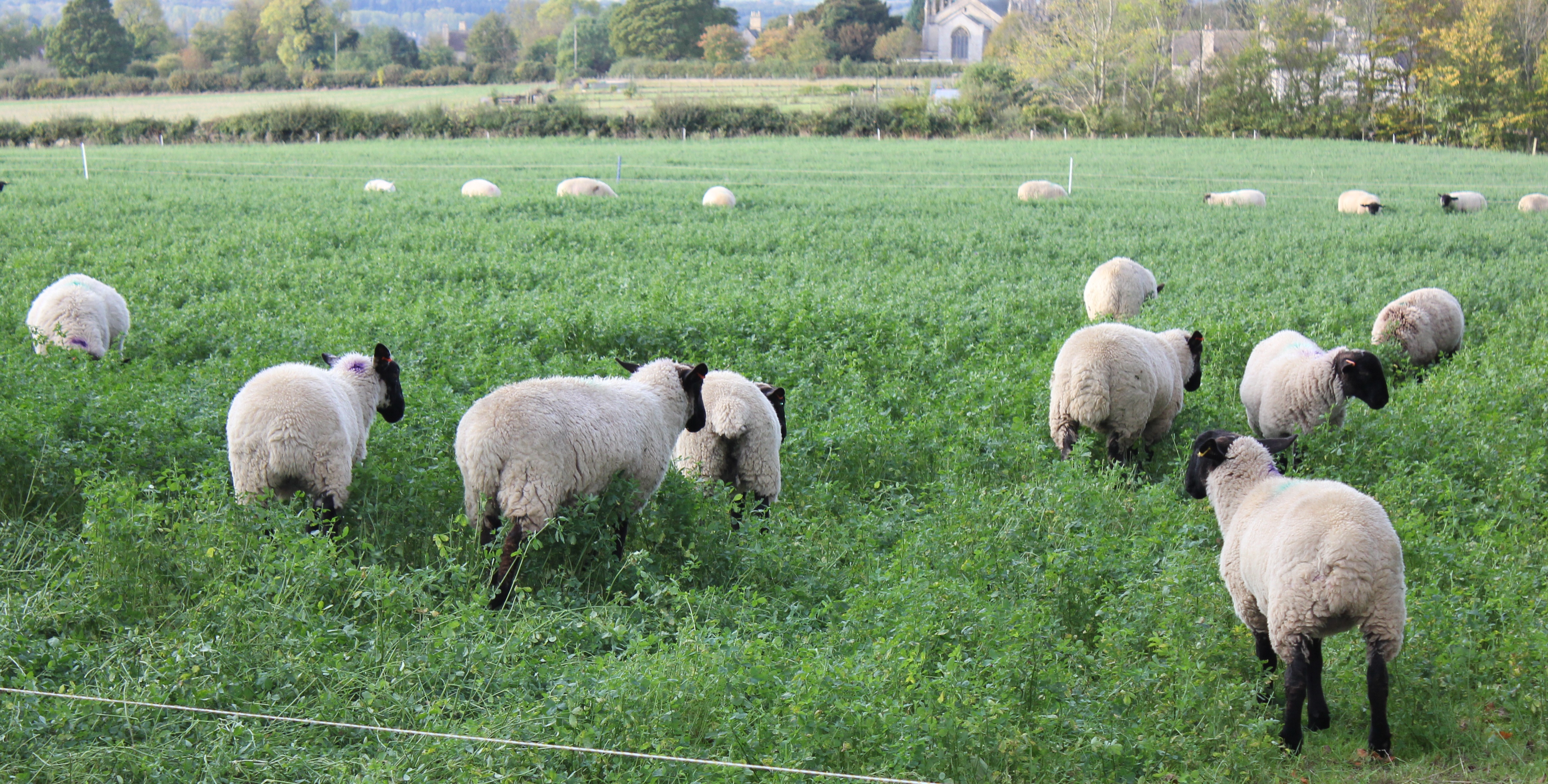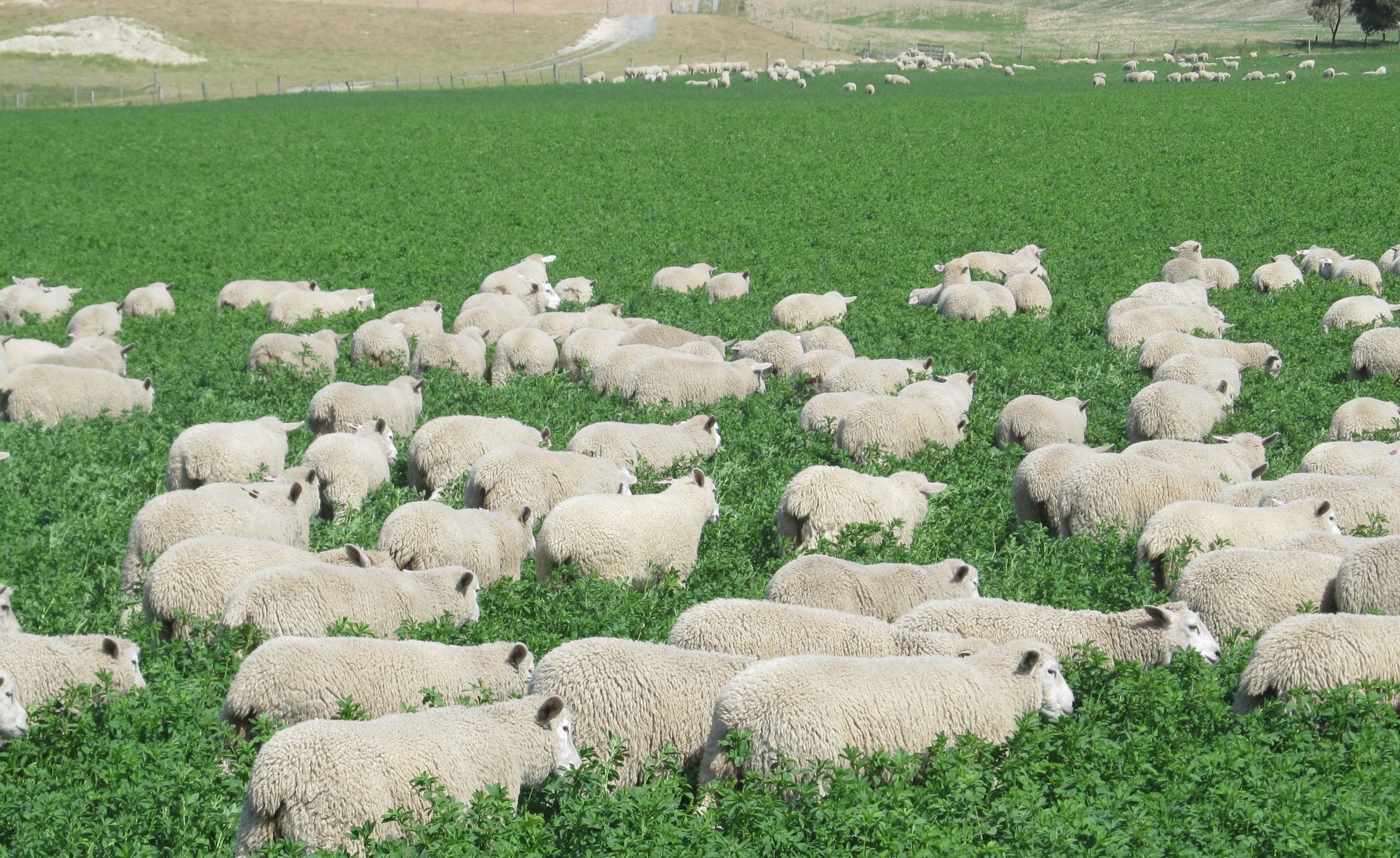- Home
- Knowledge library
- Grazing lucerne
Grazing lucerne
With careful management, lucerne provides a nutritious and highly digestible crop for grazing livestock.
Top tips for grazing lucerne
- Graze priority stock first, e.g. lambs before ewes, so they can select the more nutritious growth
- Aim for a minimum sward height of 6–7 cm. Grazing can reduce persistency, so great care must be taken not to damage the crown
- Never set-stock lucerne. It must be rotationally grazed to allow recovery time, or ensure a back fence is used if strip-grazing a field
- Work from the USA suggests that continuous stocking reduces plant survival by 15–22% over two years compared with rotational grazing
Bloat is a risk:
- Make sure animals are introduced to the crop gradually and allow for an adjustment period of up to three weeks
- Never introduce hungry animals on to the crop
- Take extra care when crops are particularly lush in spring and autumn or wet with dew
Always provide a fibre source (hay, straw). Rapid passage of high-quality feed in sheep can cause red gut.
Sodium is stored in lucerne roots, so animals may become deficient – ensure salt blocks are available .

Credit: Cotswold Seeds Ltd
Grazing lucerne: Work from New Zealand
Beef + Lamb NZ (New Zealand’s equivalent of AHDB) has invested considerable funds into researching the potential of lucerne for sheep grazing. The research focusses on increasing production from dryland systems and to re-prioritising grazing over conservation.
Scientists have found that lucerne provides four to five times the lamb production per hectare than dryland grass (300–400 kg lamb weaned per hectare compared with 80–135 kg lamb per hectare), while still using the same water resource.

Annual grazing plan
Developed by Professor Derrick Moot at Lincoln University, New Zealand.
Autumn recovery
- Allow at least 50% of the lucerne stems to have an open flower sometime from mid-summer to autumn, to encourage root recharge
- Graze if dry weather has stopped growth, but then allow recovery after rainfall until growth stops
Winter management
- Hard graze with a large group of animals once frosts stop growth
- Apply weed control 14 days later
- Node accumulation on stems sets up spring potential
- Late spray or early, light grazing drastically delays spring growth and reduces yield
Spring production
- Begin grazing with ewes and lambs at crop height of 15–20 cm
- Establish a five to six paddock rotation, which allows for 35–42 days between grazing
- Keep the animals in each paddock for seven to ten days, e.g. 60 ewes plus their lambs per hectare
- Make sure salt licks are available
- Post-weaning, ensure that the lambs only eat lucerne leaf, so stock at about 70 lambs per hectare and then let ewes follow
- During the summer, the leaf is high quality (ME >12 MJ/kg DM and CP>24%) and the stem is low quality (ME~8 MJ/kg DM and CP <14%)
- Allow 2.5–4.0 kg DM per head
- Ensure a minimum of six to eight weeks on lucerne to maximise liveweight gain, as the rumen takes time to adjust
- Do not allow the crop to flower – graze before flowering
- If the harvest is delayed, the proportion of stem will increase
Summer management
- During the summer, shorten the rotation so the animals move faster around the paddocks and they return after 30–35 days
- Water stress accelerates flowering, but leaf is still high quality
- Conserve a true surplus
Case study: John Farrow, sheep and arable producer, North Lincolnshire
Find out how John's lambs averaged growth rates of 1.5 kg per week.
We cut our lucerne/fescue mix twice and then graze finishing lambs on the aftermaths from late August until mid-winter (depending on growth). They have access to salt blocks but no other supplementary feed.
This year, an 8 ha (20 acre) block was divided into five paddocks and the sheep were rotated around (based on sward height). Lamb performance was better than similar lambs grazing roots. The lambs tended to eat the lucerne leaves and then the stalks.
Care was taken not to overgraze, because this can cause weed issues in the next season. We are also finishing lambs inside on a mix of lucerne silage with oats and barley. One group was growing at 3 kg per week, but they tend to average 1.5 kg per week.
Research: Grazing lambs
Find out how weaned lambs performed on crops of lucerne, red clover and perennial ryegrass in trials at Aberystwyth University.
Work conducted at Aberystwyth University on grazing weaned lambs on pure swards of red clover, lucerne and perennial ryegrass from July to finishing, showed that lucerne was between the crops in terms of performance.
Results from lamb grazing trial at Aberystwyth University
|
|
Red clover |
Lucerne |
Perennial ryegrass |
|
Days to slaughter |
38 |
50 |
66 |
|
Liveweight gain (g/day) |
305 |
243 |
184 |
|
Cold carcase weight (kg) |
18.4 |
18.8 |
18.8 |
|
Killing-out percentage (%) |
48 |
47 |
46 |
Source: Fraser et al., 2004
The same experiment found that lambs grazing on the different forage crops had different fatty acid compositions in their muscles, although there were no significant differences in meat eating quality.
Research: Grazing bulls
Discover how bulls averaged daily liveweight gains of 1.3 kg/day on a lucerne and barley diet.
Work from Spain found that incorporating lucerne grazing with barley supplementation of 1.8 kg DM/day, from weaning at 224 kg to target slaughter weight of 450 kg, was cost-effective when compared with feeding concentrates.
The bulls grew at 1.3 kg liveweight (LW)/day on the lucerne and barley, compared with 1.5 kg LW/day on a feedlot system.
The animals on the feedlot were finished 24 days earlier, but the cost of the lucerne-based system was 15% lower.
Further information
Lucerne as a replacement for grass silage
Effect of lucerne inclusion level and chop length on dairy cow performance

